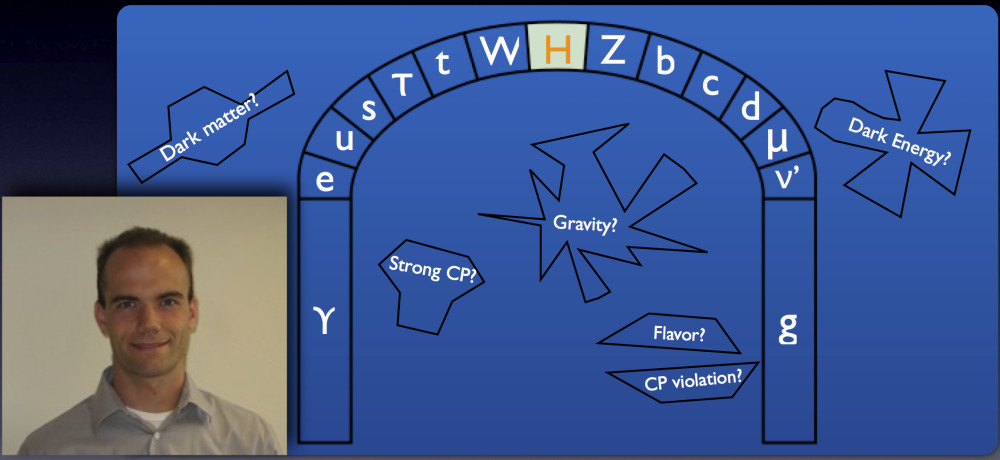On July 4th, 2012, experimental particle physicists associated with the ATLAS and CMS experiments at CERN announced the observation of a new particle with a mass near 125 GeV. This particle shares many of the characteristics with the postulated “Higgs boson,” the nature of which I will attempt to explain in this post.
You may have heard that particle physicists think a great deal about symmetry. In quantum field theory, the toolkit of modern particle theorists, there is a direct correspondence between symmetries, conservation laws, and forces. Conservation of energy, for example, is a consequence of time-translation invariance, by which we mean that an experiment performed today will yield the same result, if performed under otherwise identical conditions, tomorrow. The conservation of electric charge (and the electromagnetic force) can be linked to symmetry principles.
The Standard Model of particle physics is a quantum field theory with very particular symmetries, and these symmetries are related to the electromagnetic, weak, and strong forces and to the conservation of the charges that experience these forces. However, a straightforward implementation of these symmetries does not yield the correct behavior of the forces that we observe. Unless some additional mechanism is put to work, the weak force does not have the right behavior, and radioactive decay processes would proceed much more rapidly than observed. The electron would have only a vanishingly small mass, and would be constrained to always zip around at the speed of light, never binding to nuclei to form atoms. The field of chemistry would be obliterated!
At this point, it serves us well to draw on an analogy. Newton’s law for gravity near a small mass is symmetric. The gravitational force due to that mass depends only on the distance from it, and so the force will be the same no matter where you are, so long as you stay the same distance from the mass (this defines a sphere that has that mass at its center). So Newton’s equations are symmetric. Yet, the solutions to these symmetric equations need not share those symmetries. Keplerian orbits are elliptical, hyperbolic, or circular, and the planets of the solar system are all elliptical in shape. The moral of the story is that while the equations or laws are symmetric, the solutions to these laws need not be!
In a similar way, the solutions to the equations of the standard model don’t necessarily share all the symmetries that the equations themselves have. In particular, there is one very important solution to every quantum field theory that serves as the starting point for making any prediction. This solution is called the vacuum solution. It describes the properties of space in which there are no particles.
The simplest way that we know of to generate the kind of behavior that we observe for the weak force is for the vacuum solution itself to carry weak charge. By this, we mean that empty space carries charge. So how does one arrange this? By introducing what has been dubbed a “Higgs Field.” The Higgs field has a special property (in the lingo, it is a spin-0 or “scalar” type of field) that allows for a very unique vacuum solution: the Higgs field is “turned on” everywhere in space. That is, in a place with no particles, the Higgs field is not zero. In contrast, the electric field (or any other field in the Standard Model) has a vacuum solution value of zero.
So the Standard Model with this Higgs field can reproduce what we see in nature: suitably moderate rates for radioactive decays, a massive electron (with consequently a rich variety of atomic structures) and many other similar phenomena.
So what is the Higgs boson? In quantum field theory, particles arise as ripples in fields that exist everywhere in space and time. The vacuum solution determines what “sea-level” is for each field, and every field is allowed to ripple about this sea-level value. The Higgs boson is the particle corresponding to the ripples in the Higgs field, whose non-zero sea-level value results in the peculiar behavior of the weak force, and gives rise to the mass of the electron (and many other particles that we have discovered in particle colliders and cosmic rays).
Recently, CERN has announced that the LHC experiments have at long last obtained direct evidence for the ripples of the Higgs field, a.k.a. the long-sought Higgs boson. The discovery is now in its infancy, and theorists like myself are hard at work determining the implications of this particle for the status of many other puzzles for which we have sought answers. These puzzles are numerous, and include the mystery of dark matter, the bizarre patterns of masses that arise from the Higgs mechanism, and the matter anti-matter asymmetry of the universe. The discovery of the Higgs boson does not mark the end of a quest, but only the climactic end of a beginning.
